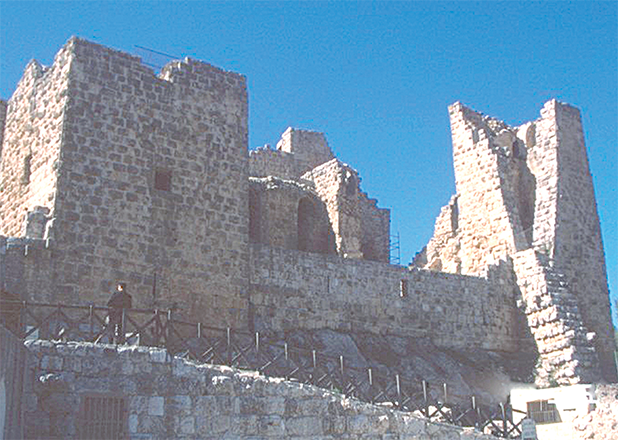AMMAN — During the turbulent period of Crusades, one of the generals of Salaheddin Ayyoubi (1137-1193 AD), Izz Al Din Usama, built in 1184 AD a monumental castle overlooking modern day Ajloun. The objective of the fortification was to protect the border with the Frankish state and Muslim pilgrims.
Ajloun Castle is the first in the line of four significant stronghold on the King’s Highway; the other three are Karak Castle, Montreal (the Shobak Castle) and Ayla (Aqaba).
Ajloun controlled the traffic between two lakes-the Dead Sea and the Sea of Galilee (or ancient Lake Tiberias) as well as pilgrimage routs from Syria to Hijaz.
The monumental castle enjoyed a strategic location with three accessible sides while the access from the southern side was difficult. Also, the trench was filled with water, especially during the time of conflict. A moat was a term for trench around the castle that would either remain dry or would be filled with water, and the practice of digging trenches was known prior to the Crusades.
Other well-known regional fortifications with a moat are Cairo Citadel, Krak des Chevaliers and Allepo Castle in Syria.
The initial structure included four dominant towers connected with the walls and wells essential for the military inside the fortification.
The second period of building added a new tower, external doors, and more refined facilities and modified paladin halls. The entrance to the castle is designed from the northeastern side and via a wooden bridge.
Two strong earthquakes hit Ajloun in 1837 and 1927 but they did not destroy the fortification, attesting to the building genius of Ayyubid-Mamluk architects and engineers.
The Battle of Hattin in 1187 AD proved decisive regarding the control of the East Bank and from that event until the end of the Crusades, Frankish control of territories east of the Dead Sea and the Jordan River declined.
“Although it took Salaheddin Ayyoubi twelve years after the death of Nur Al Din to effect the political unification of Syria and Egypt, he was most active in this period,” noted Alan Walmsley, from The University of Sydney, adding that in 1182 AD Salaheddin encamped at Jarba and conducted raids around Shobak before continuing to Damascus, while other Muslim forces took Habis Jaldak, only to lose it a few months later.
The biggest fort in Jordan, Karak, was besieged by Muslim forces in 1183 and 1184 AD, Walmsley said, it all coincided with an offensive to push Crusaders out of the East Bank.
Talking about the Ajloun Castle, Walsley continued: “All the towers and intervening walls were periodically pierced by plain arrow slits. Water was provided by five rock-cut cisterns under the castle”.
“In the early 13th century AD, after the castle was captured from Izz Al Din Usama, the defences were strengthened by the construction of a massive tower on the south side and the original structure given added height to match the new tower.”
To accommodate these changes two new gates were added, the inner one of which was decorated with birds and provided with a machicoulis accessed from the first floor. Furthermore, an inscription on the south tower dates these additions to 1214–1215, and were undertaken by Izz Al Din Aybeg, Lord of Salkhad, for the Ayyubid Prince Al Muazzam (d. 1227), son of Al Adil and his father’s successor in Damascus (1218), Walsley said.
“The dry moat that surrounds the castle must have been cut, or at least completed, as part of these additions, for it makes allowance for the projection of the south tower. Today the castle at Ajlun, named Qalat Al Rabad, shows evidence of later repairs but the plan is as Izz Al Din Aybeg left it, and hence it is a fully Ayyubid structure,” Walsley concluded.
During the great Mongol expansion of the mid-13th century, a section of the Ajloun Castle was destroyed in 1260 AD. After the Battle at Ain Jalut in northern Palestine, when Mamluk armies beat Mongol invaders the same year, the Ajloun Castle was renovated and it continued to be used until modern times.
